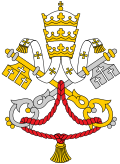| Part of a series on the |
| Roman Curia of the Holy See |
|---|
 |
| |
The Office for the Liturgical Celebrations of the Supreme Pontiff (Latin : Officium de Liturgicis Celebrationibus Summi Pontificis, Italian : Ufficio delle Celebrazioni Liturgiche del Sommo Pontefice) is the section of the Roman Curia responsible for organizing and conducting liturgies and other religious ceremonies performed by the pope of the Catholic Church. It is headed by a "master" appointed for a term of five years. [1]
Contents
The office and the consultants who advise it support the pope in expressing his interpretation of the liturgical modifications instituted following the Second Vatican Council. Popes have at times supported postconciliar reforms, restored earlier practices, and introduced further innovations. When Pope Francis named five new consultants in September 2013, he included none of those appointed by Pope Benedict XVI, who were known to promote a return to preconciliar liturgical practices. [2] [3] Benedict restored preconciliar elements to the rite for the canonization of saints and Francis removed them and further shortened the ceremony. Guido Marini, the Master when Francis instituted his changes, is known as a traditionalist, but performs to the pope's instructions. [4] In the words of one journalist, his job is "to thread papal preferences into the pageantry". [5] For example, he works to ensure that liturgical music is integrated into the liturgy as Francis prefers, so that participants are never forced to wait for music to conclude before proceeding. [6] On 19 January 2019, Pope Francis transferred responsibility for the Sistine Chapel Choir from the papal household to this Office. [7]